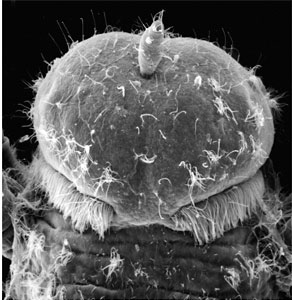capricornia
Fredrik Pleijel and Greg W. RouseIntroduction
capricornia was described by Pleijel & Rouse (2000a). It is a tiny hesionid, reaching only about 2 mm in length. It is currently known from the Great Barrier Reef and New Caledonia, where it occurs in coral gravel and sand at a few meters depth.
Characteristics
capricornia is identified by the synapomorphy paired penes situated on segment 9. It appears to be closely related to a group including Amphiduros, Amphiduropsis, Gyptis and Parahesione. Following an analysis in the original description, it was sister to the first two of these taxa, whereas in Pleijel (2001) it came out as sister to Parahesione. In part, difficulties in assessing the more precise position are likely related to its small size and the retention of many juvenile hesionid features. Unusual for hesionids, which do not usually have external genital organs (but see also Westheide et al., 1994), the males of capricornia have a pair of large penes situated on segment 9 (see title illustration of capricornia male). The females have spermathecae in the notopodia of segments 11 and 12.
capricornia and the LITU Concept
The description of capricornia was carried out in association with another paper, were we introduced the LITU concept (Least Inclusive Taxonomic Unit, Pleijel and Rouse, 2000b). This paper, together with those of Mishler (1999) and (Pleijel, 1999), contains a critique of the application of species concepts in taxonomy, and suggests that it/they should be abandoned. The critique refers both to theoretical problems with various concepts, and to the practical appications. Pleijel and Rouse commented on three of these: (1) lack of consensus on the meaning of the term "species", (2) mixture, under many concepts, of paraphyletic and monophyletic entities, and (3) impracticality, due to lack of needed information.
Phylogenetic concepts based on the identification of monophyletic species only, have been suggested, e.g., by Rosen (1979). Although we partly agree with this, it still makes an absolute claim about a group: this is a single species and it cannot be subdivided into further species. Instead we suggested LITUs, which refer to the smallest currently recognized clades. Since it is useful to be able to readily identify LITUs and separate them from more inclusive clades, it was suggested that they should be tagged in a way that could be easily changed when they shift status, such as with an initial lower case letter. This was applied in a case study that introduced the new hesionid capricornia, and this is the reason why its name is spelled without capital first letter. It is important to note that LITUs, in contrast to species, do not represent absolute statements about the internal relationships within the named group; they merely make reference to the current resolution and knowledge.
References
Mishler, B.D. 1999. Getting rid of species? In: R. A. Wilson (Ed.), Species. New interdisciplinary essays, The MIT Press, Cambridge, Massachusetts, pp. 307-315.
Pleijel, F. 1999. Phylogenetic taxonomy, a farewell to species, and a revision of Heteropodarke (Annelida, Polychaeta, Hesionidae). Syst. Biol. 48:755-789.
Pleijel, F. 2001. Revision of Amphiduros (Gyptini, Hesionidae, Polychaeta). Ophelia 54:15-27.
Pleijel, F., and Rouse, G.W. 2000a. A new taxon, capricornia (Hesionidae, Polychaeta), illustrating the LITU ("Least Inclusive Taxonomic Unit") concept. Zool. Scr. 29:157-168.
Pleijel, F., and G. W. Rouse. 2000b. Least-inclusive taxonomic unit: a new taxonomic concept for biology. Proceedings of the Royal Society of London. Series B: Biological Sciences 267:627-630.
Rosen, D.E. 1979. Fishes from the uplands and intermontane basins of Guatemala: revisionary and comparative geography. Bull. Am. Mus. nat. Hist. 162:267-376.
Westheide, W., Purschke, G., and Mangerich, W. 1994. Sinohesione genitaliphora gen. et sp. n. (Polychaeta, Hesionidae), an interstitial annelid with unique dimorphous external genital organs. Zool. Scr. 23:95-105.
Title Illustrations

About This Page
Fredrik Pleijel

Muséum national d'Histoire naturelle Paris, France
Greg W. Rouse

Scripps Institution of Oceanography
Correspondence regarding this page should be directed to Fredrik Pleijel at and Greg W. Rouse at
Page copyright © 2004 and Greg W. Rouse
All Rights Reserved.
- First online 13 April 2004
- Content changed 13 April 2004
Citing this page:
Pleijel, Fredrik and Greg W. Rouse. 2004. capricornia . Version 13 April 2004. http://tolweb.org/capricornia/22822/2004.04.13 in The Tree of Life Web Project, http://tolweb.org/











 Go to quick links
Go to quick search
Go to navigation for this section of the ToL site
Go to detailed links for the ToL site
Go to quick links
Go to quick search
Go to navigation for this section of the ToL site
Go to detailed links for the ToL site